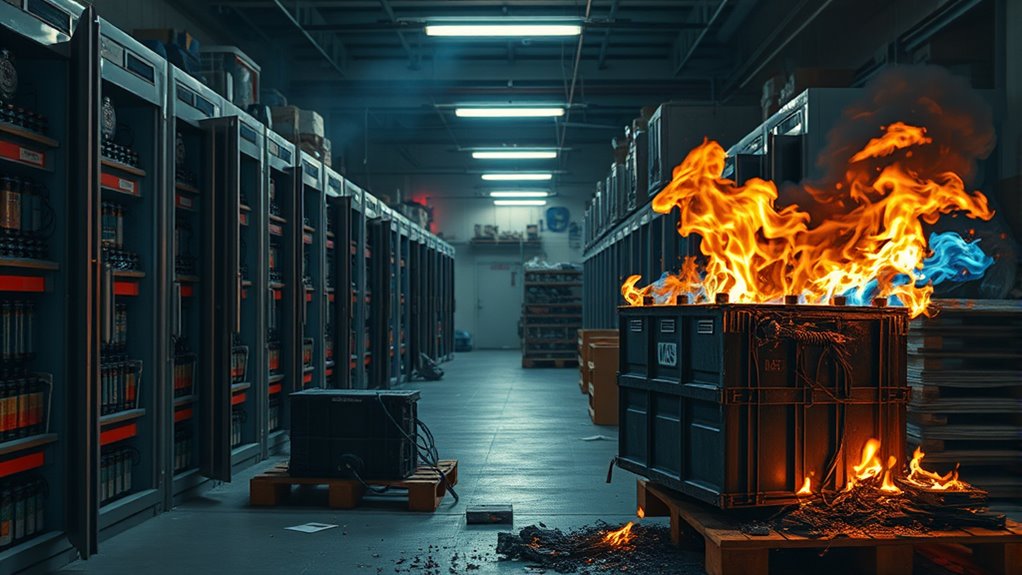To reduce fire risks from lithium-ion batteries, store them in a cool, dry place away from heat and sunlight, preferably at around 50% charge. Use only manufacturer-approved chargers, unplug once fully charged, and never leave them unattended during charging. Handle damaged or overheated batteries carefully and in fire-safe containers. Following proper storage and charging practices can markedly lower the chance of fire; explore further to learn detailed safety measures.
Key Takeaways
- Store lithium-ion batteries in a cool, dry place at around 50% charge to minimize risk.
- Use only manufacturer-approved chargers and unplug once fully charged.
- Avoid storing multiple batteries together in confined spaces to prevent heat buildup.
- Disconnect and safely handle batteries showing signs of damage or overheating.
- Keep appropriate fire extinguishers nearby and avoid water on lithium fires.

Lithium-ion batteries power many of your everyday devices, but they also pose important fire risks if mishandled or damaged. One of the most dangerous scenarios is thermal runaway, a chain reaction where the battery’s internal temperature rapidly escalates, causing the electrolyte to ignite or explode. When a lithium-ion battery experiences damage, manufacturing defects, or improper charging, it can trigger this runaway process. Once it begins, it becomes difficult to control, and the heat generated can quickly lead to a fire. That’s why understanding proper storage and charging practices is vital for safety.
Storing batteries correctly minimizes risks. Keep them in a cool, dry place, away from direct sunlight and sources of heat. Avoid storing multiple batteries together in a confined space, as a single damaged or overheating battery could transfer heat to others, increasing the chance of thermal runaway. When not in use, store batteries at approximately 50% charge rather than fully charged or depleted, which helps reduce stress on the cells and prolongs their lifespan. Proper packaging is also essential—use original containers or fire-resistant storage cases designed for batteries, especially if you’re storing multiple units or spares. This containment can slow the spread of fire if thermal runaway occurs, giving you more time to react.
Charging batteries improperly is another major risk factor. Always use the charger specified by the manufacturer, and avoid overcharging by unplugging the device once it reaches full capacity. Charging in well-ventilated areas prevents heat buildup, which can accelerate thermal runaway. Never leave charging devices unattended for extended periods, and be cautious with fast chargers or third-party chargers not approved by the manufacturer. If a battery becomes excessively hot, swollen, or shows signs of damage, disconnect it immediately and place it in a fire-safe container—don’t try to handle it with bare hands.
In the event of a fire caused by a lithium-ion battery, fire suppression measures are vital. Water may not always be effective and can sometimes worsen the situation due to the chemical nature of the battery’s electrolyte. Specialized fire extinguishers, such as Class D or those designed for lithium fires, are recommended for such incidents. Keep a fire extinguisher nearby if you regularly handle large quantities of batteries or if you store them in high quantities. Being prepared and following proper storage and charging guidelines greatly reduces the risk of thermal runaway and helps protect your safety should a fire occur.
Frequently Asked Questions
Can Lithium-Ion Batteries Spontaneously Combust Without Warning?
Yes, lithium-ion batteries can spontaneously combust without warning. You might notice battery swelling, which indicates internal damage. If the battery overheats or experiences a thermal runaway, it can ignite suddenly. Always monitor your batteries for swelling, avoid overcharging, and store them properly. If you see any signs of damage, dispose of the battery safely to prevent potential fires. This proactive approach helps minimize the risk of unexpected combustion.
What Are the Environmental Impacts of Lithium-Ion Battery Fires?
When lithium-ion batteries ignite, they release a wildfire of toxic chemicals, like a storm tearing through a delicate ecosystem. You might not see the ecological consequences immediately, but they seep into soil and water, disrupting wildlife and contaminating resources. Proper battery recycling can help mitigate these environmental impacts, reducing ecological consequences and preventing hazardous waste from fueling future fires. Ignoring safe handling only deepens the scars on our planet’s fragile balance.
How Do Storage Temperatures Affect Lithium-Ion Battery Safety?
You should keep lithium-ion batteries within recommended storage temperature thresholds to guarantee thermal stability. Temperatures that are too high can weaken the battery’s internal structure, increasing the risk of thermal runaway and fires. Conversely, extremely low temperatures can reduce performance and cause condensation issues. To stay safe, store batteries in a cool, dry place, avoiding temperature extremes that compromise their thermal stability and overall safety.
Are There Specific Fire Suppression Methods for Lithium-Ion Battery Fires?
You should use specialized fire suppression techniques for lithium-ion battery fires, as regular extinguishers may be ineffective. Class D fire extinguishers, which contain dry powder like sodium chloride or copper powder, are the best choice. Avoid water-based extinguishers, since they can worsen the fire. Always have the right fire extinguisher types on hand, and call emergency services immediately if a lithium-ion battery fire occurs.
How Can Manufacturers Improve Lithium-Ion Battery Fire Resistance?
Did you know that proper thermal management can reduce lithium-ion battery fires by up to 60%? You can improve fire resistance by incorporating advanced materials that withstand higher temperatures and prevent thermal runaway. Manufacturers should focus on innovative thermal management systems, like phase-change materials or better insulation. These enhancements help contain heat and minimize fire risk, making batteries safer for consumers and reducing the chances of catastrophic failures.
Conclusion
Remember, handling lithium-ion batteries is like walking a tightrope—balance is key. By following proper storage and charging guidelines, you prevent turning a small spark into a blazing inferno. Think of it as tending a fragile flame; a single careless misstep can ignite chaos. Stay vigilant, respect the batteries’ power, and you’ll keep your space safe, much like a careful gardener nurturing a delicate bloom—guarded from harm but full of potential.
With a heart that soars as high as the skies, Aria, affectionately known as “Skylark,” is the driving force behind Soaring Skyways. Her journey into the gliding world began as a young dreamer gazing up at the soaring birds, yearning to experience the weightlessness and freedom they embodied. With years of experience both in the cockpit and behind the scenes, Aria’s commitment to the gliding community is unwavering.









